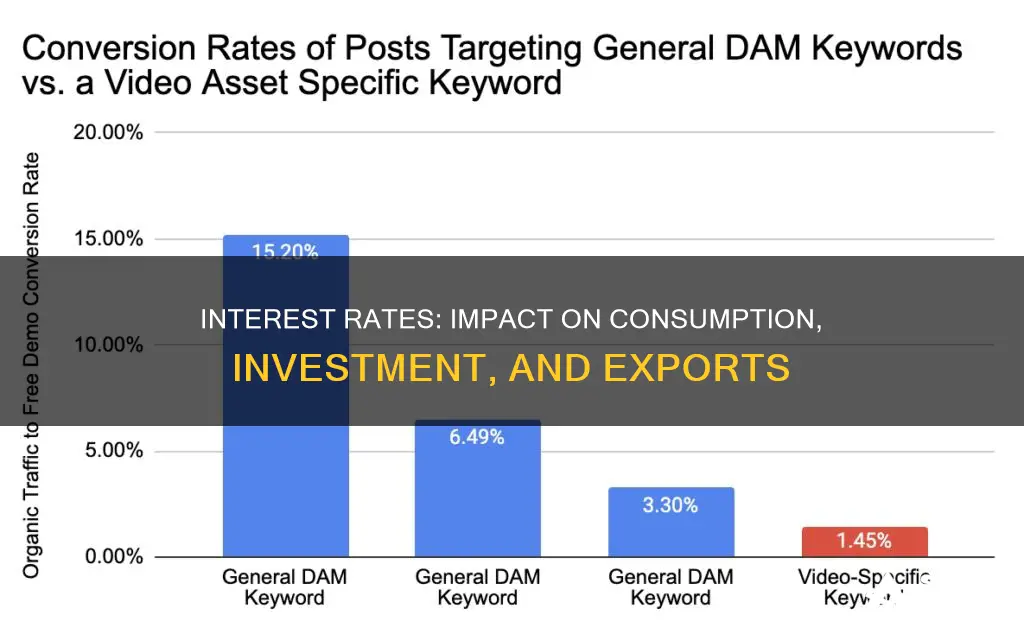
Interest rates have a significant impact on consumption, investment, and net exports. When interest rates rise, the opportunity cost of consumption increases, leading to reduced spending and a downward shift in the consumption function. Conversely, lower interest rates encourage consumption and investment by making financing more accessible and affordable. They also influence net exports through their effect on exchange rates: a decrease in interest rates can lead to a depreciation of the domestic currency, making exports more competitive and profitable, while imports become more expensive. This, in turn, increases net exports and aggregate demand over time. Understanding the relationship between interest rates and these economic variables is crucial for policymakers and economists in managing a country's economy and formulating effective monetary policies.
| Characteristics | Values |
|---|---|
| Interest rates and consumption | Higher interest rates cause people to save more, borrow less, and spend less. |
| Interest rates and investment | Higher interest rates reduce investment expenditure. |
| Interest rates and net exports | Higher interest rates cause the domestic currency to appreciate, leading to a fall in exports and a rise in imports, reducing net exports. |
What You'll Learn

How interest rates affect exchange rates
Interest rates have a significant impact on exchange rates, which in turn affects a country's consumption, investment, and net exports. When interest rates rise, the domestic currency appreciates, and the exchange rate falls. This appreciation of the domestic currency makes exports more expensive and less competitive, while imports become cheaper, leading to a decrease in net exports and aggregate expenditure.
The relationship between interest rates and exchange rates is complex and dynamic. A change in interest rates can trigger a chain reaction that influences consumption, investment, and net exports. For example, when interest rates decrease, consumption and investment expenditure increase as individuals and businesses have easier access to cheaper credit. This increase in consumption and investment can stimulate economic growth and positively impact net exports.
On the other hand, when interest rates increase, consumption and investment tend to decrease. Higher interest rates make borrowing more expensive, discouraging individuals and businesses from taking out loans or making large purchases. This decrease in consumption and investment can lead to a slowdown in economic activity and a potential reduction in net exports.
Additionally, expectations about future interest rates can also influence exchange rates and net exports. If there is an expectation of rising interest rates in the future, investors may anticipate higher returns and be more inclined to invest in a particular country's currency, leading to an appreciation of that currency. Conversely, if interest rates are expected to fall, investors may seek alternative investment opportunities, potentially leading to a depreciation of the currency.
In summary, interest rates play a crucial role in shaping exchange rates, which have a direct impact on a country's net exports. The relationship between interest rates and exchange rates is intricate and subject to various economic factors. Changes in interest rates can have far-reaching consequences for a country's economy, affecting consumption, investment, and the overall demand for its exports.
Strategies for Investing in Compound Interest Opportunities
You may want to see also

How interest rates affect net exports
Interest rates can have a significant impact on net exports. When interest rates rise, the opportunity cost of consumption increases, causing people to save more, borrow less, and spend less. This leads to a decrease in consumption and investment expenditure.
In terms of net exports, a rise in interest rates can lead to a fall in exports and a rise in imports, reducing net exports. This is because, with other things remaining constant, a rise in interest rates causes the domestic currency to appreciate and the exchange rate to fall.
On the other hand, lower interest rates can increase net exports by making exports more competitive and profitable and imports more expensive. For example, the depreciation of the Canadian dollar in 2014, followed by a lowering of interest rates by the Bank of Canada, led to an increase in the Cdn/US dollar exchange rate, making Canadian exports more attractive to US buyers. Over time, this should lead to an increase in net exports and aggregate demand.
The relationship between interest rates and net exports is also influenced by the exchange rate effects, which reinforce the negative relationship between interest rates and expenditures in the consumption and investment functions. Changes in interest rates can impact exchange rates, which in turn affects net exports and aggregate expenditure.
Venture Capitalists: Interest Rates, Loans, and Investment Bankers Compared
You may want to see also

How interest rates affect consumption
Interest rates have a direct impact on consumption, investment, and net exports. When interest rates rise, the opportunity cost of consumption increases, leading to reduced spending and a downward shift in the consumption function. Conversely, lower interest rates stimulate consumption by making borrowing more affordable and increasing disposable income. This relationship is reflected in the inverse slope of the consumption function, where a decrease in interest rates results in an increase in consumption expenditure.
The impact of interest rates on consumption is closely tied to the availability and cost of finance. Lower interest rates reduce the cost of borrowing, making it more attractive for individuals and businesses to take out loans to finance purchases. This increase in borrowing can lead to higher levels of consumption, particularly for durable goods such as houses and cars, which often require significant financing.
Additionally, interest rates can influence consumption through their effect on exchange rates. A decrease in interest rates can lead to a depreciation of the domestic currency, making exports more competitive and imports more expensive. This improves the trade balance, resulting in higher net exports and increased aggregate demand. Over time, this can lead to higher levels of production and income, which can further stimulate consumption.
Expectations about future income, prices, and tax policies can also influence current consumption decisions. For example, if individuals anticipate higher future income, they may be more inclined to spend rather than save. Similarly, expectations of higher future prices for real assets can encourage current consumption as individuals seek to take advantage of lower prices. On the other hand, concerns about job security and future income can lead to reduced consumption spending at all levels of disposable income.
In summary, interest rates play a significant role in shaping consumption patterns. Changes in interest rates can affect the cost and availability of credit, exchange rates, and expectations about future economic conditions, all of which influence consumption decisions. Understanding these dynamics is crucial for policymakers and economists in managing the economy and promoting sustainable growth.
Invest Wisely, Live Comfortably Off Your Interest
You may want to see also

How interest rates affect investment
Interest rates have a direct impact on investment. When interest rates are low, investment expenditure increases, as the cost of finance is lower. This makes it easier for businesses to borrow money to invest in their operations, such as purchasing new equipment or expanding their facilities.
On the other hand, when interest rates rise, investment expenditure decreases. Higher interest rates make borrowing more expensive, which discourages businesses from taking out loans for investments. This is because the opportunity cost of borrowing increases, as the same amount of money could be invested elsewhere to earn a higher return.
The relationship between interest rates and investment can be seen in the aggregate expenditure model, where the consumption, investment, and net export components of autonomous expenditure are inversely related to the interest rate. This means that as interest rates increase, investment decreases, and vice versa.
Additionally, changes in interest rates can also impact investment indirectly through their effect on exchange rates. When interest rates fall, the domestic currency depreciates, making exports more competitive and profitable. This can lead to an increase in net exports, which may encourage businesses to invest more in their operations to meet the higher demand. Conversely, when interest rates rise, the domestic currency appreciates, making exports more expensive and less competitive, which can reduce net exports and discourage investment.
Overall, interest rates play a significant role in influencing investment decisions. Businesses consider the cost of borrowing and the potential returns when deciding whether to invest, and interest rates are a key factor in this calculation.
Interest Impact: Investment Numbers and Strategies Explored
You may want to see also

How interest rates affect aggregate demand
Interest rates have a significant impact on aggregate demand through their influence on consumption, investment, and net exports. When interest rates rise, the opportunity cost of consumption increases, leading to reduced spending and a downward shift in the consumption function. This decrease in consumption results from savers saving more, borrowing less, and spending less due to higher interest rates.
On the other hand, lower interest rates stimulate consumption and investment expenditure. They make borrowing more attractive, increasing investment and consumption spending. Lower interest rates also positively impact net exports by depreciating the domestic currency, making exports more competitive and profitable while making imports more expensive. This depreciation of the domestic currency occurs through the effect of lower interest rates on the foreign exchange rate.
The relationship between interest rates and aggregate demand can be further understood through the expenditure function. A fall in interest rates increases expenditure, moving along the expenditure function. This increase in expenditure leads to higher consumption and investment spending. Additionally, lower interest rates contribute to an increase in net exports, as explained earlier.
The inverse relationship between interest rates and the components of autonomous expenditure, including consumption, investment, and net exports, is illustrated by the downward-sloping line A(i). This line demonstrates how an increase in interest rates leads to a decrease in these components, while a decrease in interest rates has the opposite effect, boosting consumption, investment, and net exports.
In summary, interest rates play a crucial role in shaping aggregate demand. Higher interest rates tend to reduce consumption, investment, and net exports, while lower interest rates stimulate these components, ultimately influencing the overall level of aggregate demand in an economy.
Navigating Smartly: Investing in a Megarive Interest Rate Environment
You may want to see also
Frequently asked questions
An increase in interest rates will cause people to save more, borrow less and spend less. This will cause the consumption function to shift downward.
Interest rate changes affect exchange rates, which in turn change net exports and aggregate expenditure. Lower interest rates increase net exports by making exports more competitive and profitable and imports more expensive.
Lower interest rates increase consumption and investment expenditure directly through wealth and cost and availability of finance effects.







